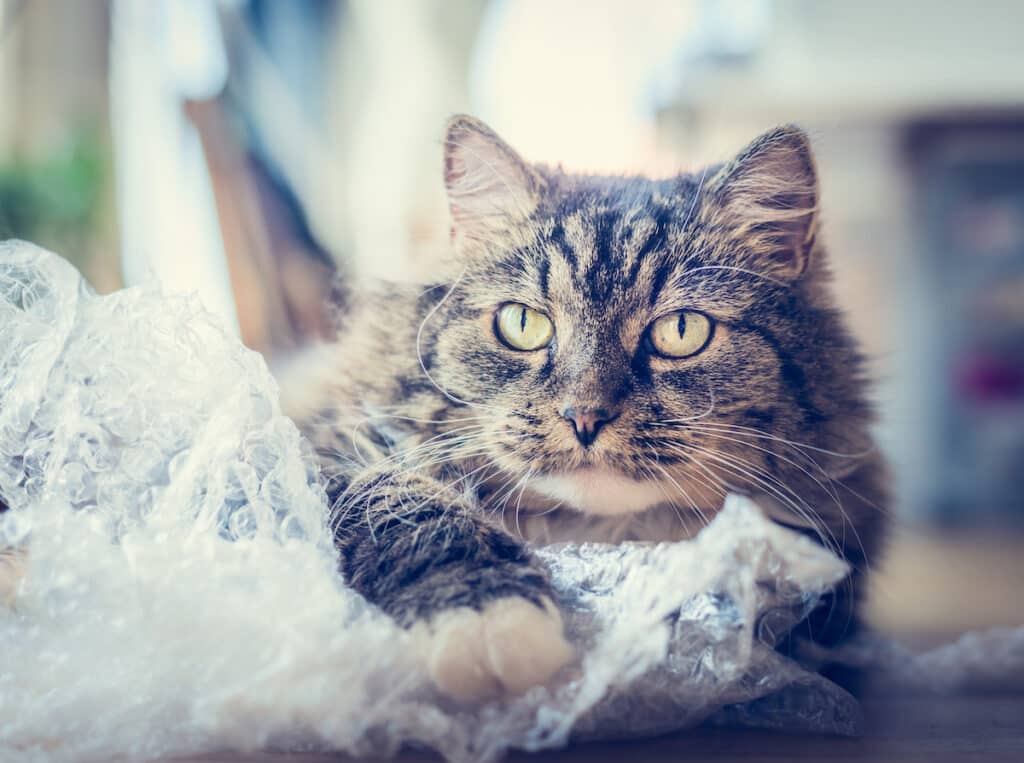Cats are known for their curious and sometimes quirky behavior, and one of the most puzzling habits is their tendency to chew on and even consume plastic. Whether it’s plastic bags, packaging, or household items, many cat owners have observed their feline friends indulging in this unusual habit. But what drives cats to eat plastic?
First, it’s important to note that cats eating plastic is not a normal behavior and should be taken seriously. Consuming plastic can lead to a variety of health problems, including choking, intestinal blockages, and even poisoning if the plastic contains toxic chemicals.
So, why do cats eat plastic in the first place? There are several theories, but no definitive answer. Here are a few possibilities:
1. Pica
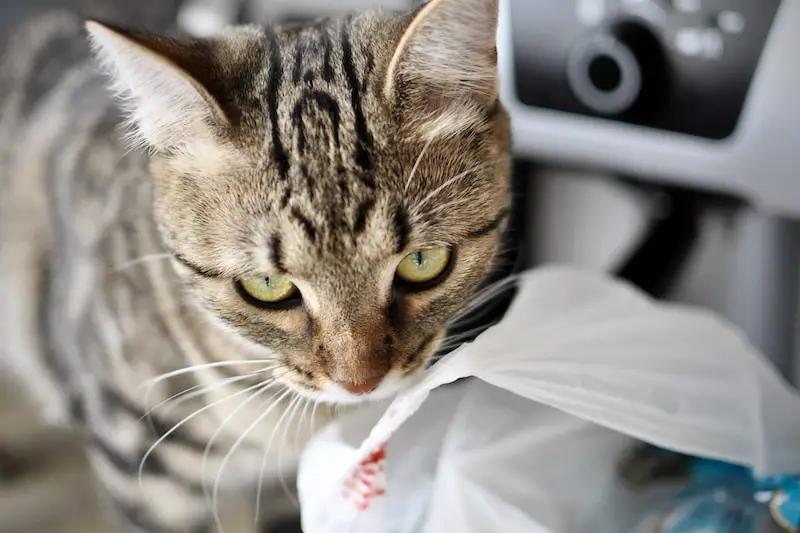
Pica is a disorder characterized by the consumption of non-food items, such as plastic, wool, or paper. While pica can affect any animal, it’s more common in cats and dogs. Pica is thought to be caused by a combination of environmental and genetic factors, and it may be related to stress, anxiety, or nutritional deficiencies.
Several breeds of cats, including Siamese, Burmese, and Oriental Shorthair, are known to be susceptible to feline pica.
Pica in cats is often triggered by stress, especially in kittens. Other causes include feline leukemia, gastrointestinal diseases, and mental abnormalities. However, most cats grow out of their suckle behavior by the age of six months.
A cat that is suffering from pica can develop a gastrointestinal blockage if the nonfood object is ingested. This can be dangerous and can lead to suffocation. Cats that have severe cases of pica often consume inedible objects, such as electrical cords.
2. Play behavior
Cats are playful creatures, and they often explore their environment by mouthing objects. Some cats may simply find plastic bags or packaging interesting and chew on them as a form of play. This behavior may also be related to teething in kittens.
3. Attention-seeking
Cats are social animals, and they crave attention from their owners. If your cat has learned that chewing on plastic gets your attention, they may continue to do it to get a reaction from you.
4. Hunger or boredom
Cats may also eat plastic out of hunger or boredom. If your cat is not getting enough food or stimulation, they may resort to chewing on non-food items as a way to relieve their frustration.
Some cats seem to really like the feeling of chewing plastic on their teeth and mouths. Perhaps there are parallels between the feeling of plastic and bone marrow or other parts of the prey wild cats would eat.
Much like how dogs like to chew on bones, cats might like to chew on plastic.
How to Stop Your Cat From Eating Plastic
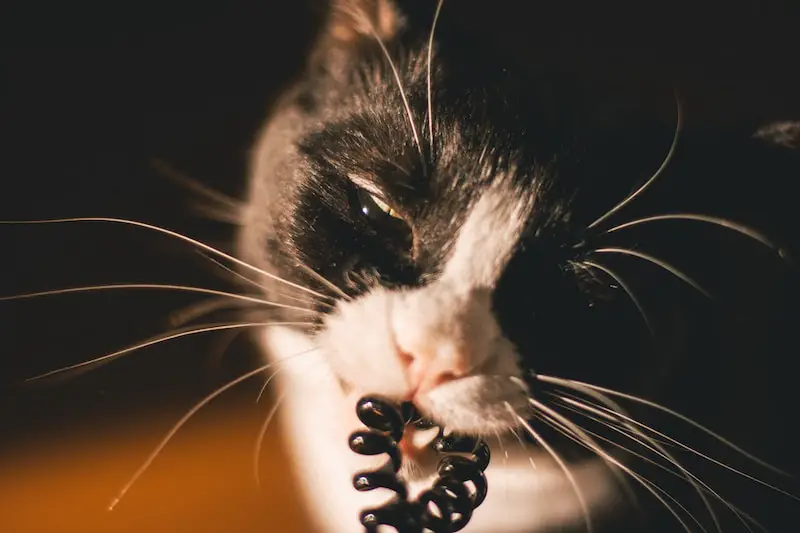
Now that we’ve explored some of the reasons behind this behavior, what can you do to prevent it? Here are a few tips:
Keep plastic items out of reach
The most effective way to prevent your cat from eating plastic is to keep it out of their reach. Store plastic bags and packaging in a secure location, and keep household items made of plastic, such as shower curtains or plastic plants, away from your cat.
Provide plenty of toys and playtime
Make sure your cat has plenty of toys to play with and provide regular playtime to keep them mentally stimulated. This can help prevent boredom and reduce the likelihood of your cat turning to plastic for entertainment.
Address underlying health or behavioral issues
If you suspect your cat’s plastic-eating behavior is related to an underlying health or behavioral issue, such as pica or anxiety, talk to your veterinarian. They can help diagnose the problem and provide guidance on how to address it.
Dangers of Cats Eating Plastic
Many cat owners may not realize that eating plastic can have serious consequences for their furry friends. We’ll lay out the potential dangers of cats eating plastic and what symptoms to look out for.
Choking and Suffocation
One of the most immediate and serious risks associated with cats eating plastic is the risk of choking or suffocation. Cats may accidentally swallow small pieces of plastic or get a plastic bag wrapped around their head or neck, leading to life-threatening situations.
Intestinal Blockages
Cats who eat plastic are at risk of developing intestinal blockages, which occur when a foreign object obstructs the digestive tract. Plastic is not easily digestible and can get stuck in your cat’s digestive system, causing severe pain, vomiting, and diarrhea. In some cases, surgery may be required to remove the blockage.
Toxicity
Certain plastics contain chemicals that are toxic to cats, such as phthalates, BPA, and lead. When cats chew on plastic, they may ingest these chemicals, leading to poisoning. Symptoms of plastic toxicity include vomiting, diarrhea, lethargy, and seizures. If you suspect your cat has ingested toxic plastic, seek veterinary care immediately.
Dental Problems
Chewing on hard plastic can also cause dental problems for cats, including tooth fractures, chipped teeth, and gum damage. These issues can be painful for your cat and may require dental care from a veterinarian.
Behavioral Issues
Finally, cats who eat plastic may develop behavioral issues, such as pica, a condition characterized by the consumption of non-food items. Pica can be caused by stress, anxiety, boredom, or nutritional deficiencies and may require veterinary intervention.
Symptoms of Plastic Ingestion in Cats
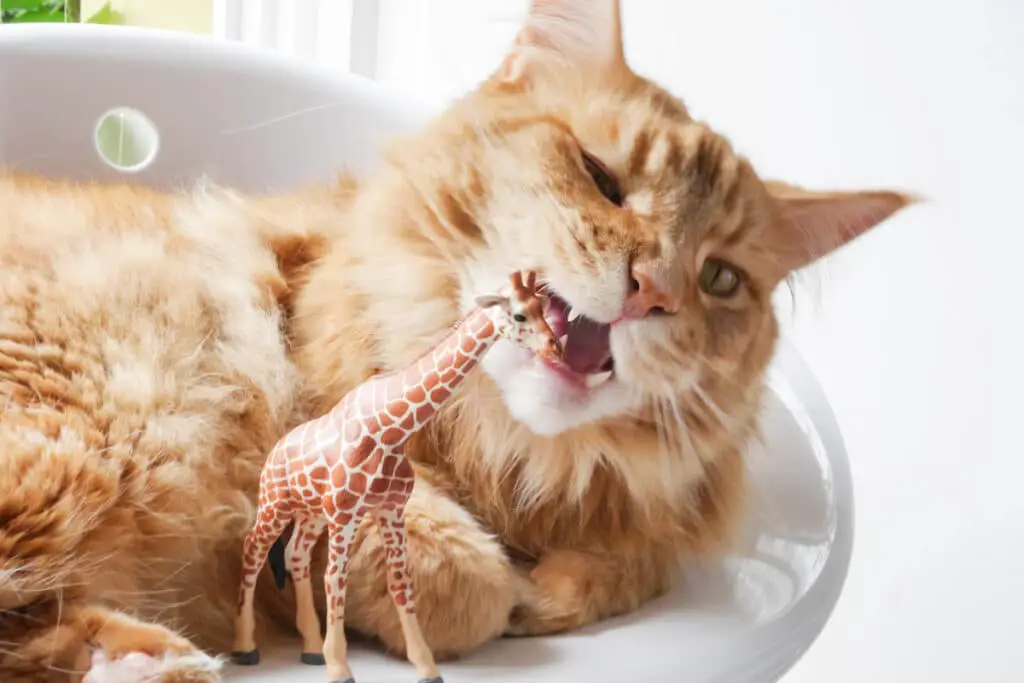
If your cat has ingested plastic, there are several symptoms to watch for that may indicate a problem. Here are some common symptoms of plastic ingestion in cats:
- Vomiting: One of the most common signs of plastic ingestion in cats is vomiting. If your cat has ingested plastic, they may vomit repeatedly or show signs of discomfort after eating.
- Diarrhea or constipation: Ingesting plastic can also cause digestive issues such as diarrhea or constipation. Your cat may have difficulty passing stools or may produce loose, watery stools.
- Loss of appetite: Cats that have ingested plastic may also show a decreased appetite or may refuse to eat altogether.
- Lethargy or weakness: If the plastic has caused a blockage in your cat’s intestines, they may become lethargic or weak. They may also appear to be in pain or discomfort.
- Behavioral changes: Ingesting plastic can also cause changes in your cat’s behavior, such as increased anxiety, aggression, or restlessness.
Worst Types of Plastic for Cats to Eat
While any type of plastic can be harmful if ingested, some types of plastic are more dangerous for cats than others. Here are some of the worst types of plastic for your cat to eat:
- Soft plastics: Soft plastics, such as plastic bags, cling wrap, and packaging materials, are particularly dangerous for cats as they can easily become lodged in the digestive tract, causing blockages or tears in the intestines.
- Hard plastics: Hard plastics, such as plastic toys or parts from household appliances, can also pose a risk to cats. These types of plastics can cause dental damage or may break apart into small pieces that can be swallowed, leading to intestinal blockages.
- Styrofoam: Styrofoam is a type of plastic foam often used in packaging materials and disposable food containers. If ingested, it can cause serious digestive issues, as it does not break down in the digestive tract and can become lodged in the intestines.
- Polycarbonate plastics: Polycarbonate plastics are commonly used in food and drink containers, as well as some household appliances. These types of plastics contain bisphenol-A (BPA), which has been linked to a variety of health issues in humans and animals, including hormonal imbalances and reproductive problems.
Other Non-Food Items Cats Eat
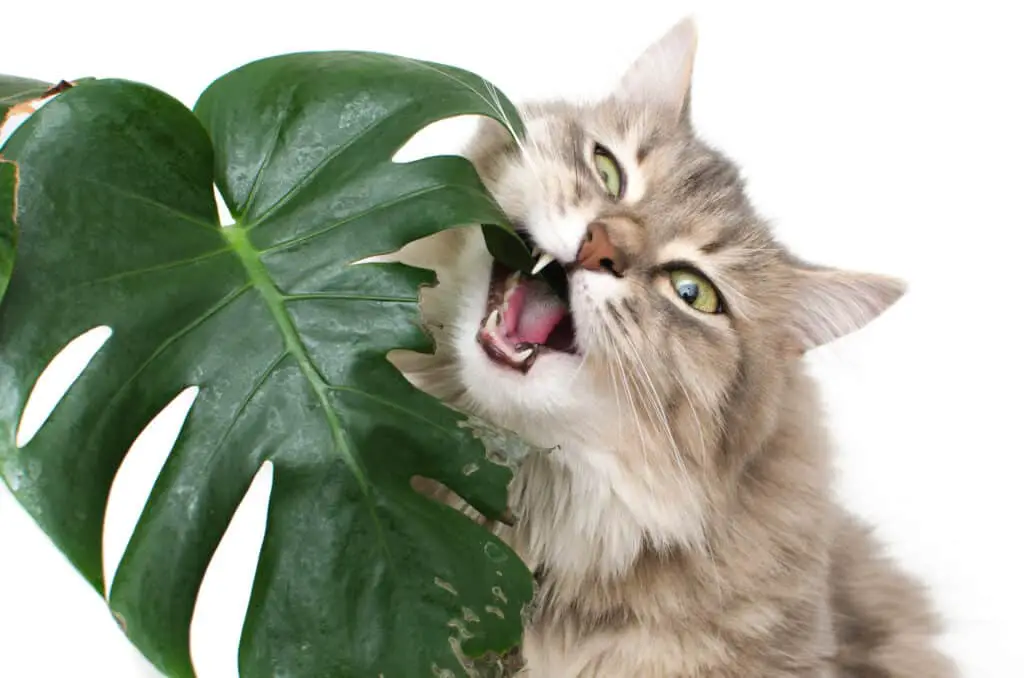
Cats are known for their discerning palate, but they are also known to eat some unusual things. In addition to plastic, cats have been known to consume a variety of other non-food items. Some common examples include:
- Plants: Many cats are drawn to houseplants and may eat them out of curiosity or boredom. However, some plants can be toxic to cats and may cause digestive issues or more serious health problems.
- Hair: Cats are notorious for grooming themselves, and they may inadvertently swallow hair in the process. In some cases, this can lead to hairballs or even intestinal blockages.
- Insects: Cats are natural predators, and it’s not uncommon for them to eat insects such as spiders, flies, or moths. While some insects can be a good source of protein, others may carry diseases or toxins.
- String or thread: Cats are often attracted to string or thread, but this can be dangerous if they swallow it. The string can become entangled in their intestines, leading to a potentially life-threatening blockage.
- Paper: Like plastic, paper can be a tempting target for cats, particularly if it’s crinkly or has an interesting texture. While small amounts of paper are unlikely to cause any harm, consuming large amounts can lead to digestive issues.
It’s important to monitor your cat’s behavior and eating habits to ensure that they are not consuming anything that could be harmful to their health. If you notice any unusual behavior or digestive issues, it’s always best to consult with your veterinarian to rule out any underlying medical conditions or dietary deficiencies.
FAQs: Why Do Cats Eat Plastic?
Pica syndrome in cats is a condition characterized by the consumption of non-food items, such as plastic, fabric, paper, or other objects that are not part of a normal feline diet. This behavior is often associated with nutritional deficiencies, stress, anxiety, or boredom. Cats with pica may exhibit a range of symptoms, including vomiting, diarrhea, constipation, abdominal pain, and decreased appetite.
It’s important to note that pica syndrome is not a disease in and of itself but rather a symptom of an underlying condition. If you suspect that your cat has pica syndrome, it’s important to consult with your veterinarian to determine the underlying cause and develop a treatment plan.
It depends on the amount and type of plastic your cat has ingested. If your cat has only ingested a small amount of plastic and is showing no signs of discomfort or illness, they may pass the plastic through their digestive system without any issues. However, if your cat has ingested a large amount of plastic or if the plastic has caused a blockage in their digestive tract, it can lead to serious health complications.
If you suspect that your cat has ingested plastic, it’s important to monitor them closely for any signs of discomfort, such as vomiting, diarrhea, abdominal pain, or loss of appetite. If your cat exhibits any of these symptoms, it’s essential to seek veterinary care immediately. Your veterinarian can perform an examination, take X-rays or perform an ultrasound to determine if there is a blockage or other health issues.
In some cases, surgical intervention may be required to remove the plastic or to treat any complications that have arisen as a result of the ingestion. However, if caught early and treated promptly, many cats who have ingested plastic can make a full recovery.
Treatment of cat pica may include changes to your cat’s diet or environment, behavioral modification techniques, or medication to address any underlying medical conditions. With proper treatment, many cats with pica syndrome can overcome their compulsive behavior and lead happy, healthy lives.
Determining whether your cat has pica can be challenging, as many cats may display an occasional interest in non-food items without necessarily having the condition. However, if your cat is regularly ingesting non-food items or showing a compulsive behavior toward certain objects, it may be a sign of pica. Some common signs and symptoms of pica in cats include:
– Eating non-food items, such as plastic, fabric, paper, or other objects that are not part of a normal feline diet.
– Chewing or licking objects obsessively, such as walls, floors, or furniture.
– Showing a lack of interest in food or a decreased appetite.
– Exhibiting signs of discomfort, such as vomiting, diarrhea, or constipation.
– Changes in behavior or mood, such as increased anxiety or aggression.

